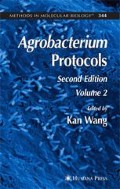Abstract
Although species within the genus Populus are, in general, easier to transform and regenerate in vitro than most other trees, many poplar species are very recalcitrant. Many protocols that previously have been reported were developed for a specific genotype or species. Thus, it has often been necessary to re-optimize a protocol each time research is initiated with a new genotype. The method presented in this chapter has been effective for a wide variety of poplar genotypes.
Access this chapter
Tax calculation will be finalised at checkout
Purchases are for personal use only
References
Eckenwalder, J.E. (1996) Systematics and evolution of Populus. In: Biology of Populus and its Implication for Management and Conservation (Stettler, R.F., Bradshaw, H.D., Jr., Heilman, P.E., and Hinckley, T.M., eds.), National Research Council Canada, Ottawa, ON, pp. 201–222.
DeBlock, M. (1990) Factors influencing the tissue culture and the Agrobacterium tumefaciens-mediated transformation of hybrid aspen and poplar clones. Plant Physiol. 93, 1110–1116.
Confalonieri, M., Balestrazzi, A., and Bisoffi, S. (1994) Genetic transformation of Populus nigra by Agrobacterium tumefaciens. Plant Cell Rep. 13, 256–261.
Confalonieri, M., Balestrazzi, A., Bisoffi, S., and Cella, R. (1995) Factors affecting Agrobacterium tumefaciens-mediated transformation in several black poplar clones. Plant Cell Tissue. Org. Cult. 43, 215–222.
Huang, F.H. (1994) Putatively Agrobacterium tumefaciens-mediated transformation of glyphosate tolerant hybrid poplar strain NC 5331. Q. J. Chin. For. 27, 43–50.
Wang, G., Castiglione, S., Chen, Y., et al. (1996) Poplar (Populus nigra L.) plants transformed with a Bacillus thuringiensis toxin gene: Insecticidal activity and genomic analysis. Transgen. Res. 5, 289–301.
Heuchelin, S.A., McNabb, H.S., and Klopfenstein, N.B. (1997) Agrobacterium-mediated transformation of Populus × euramericana “Ogy” using the chimeric CaMV 35S-pin2 gene fusion. Can. J. For. Res. 27, 1041–1048.
Han, K.-H., Meilan, R., Ma, C., and Strauss, S.H. (2000) An Agrobacterium transformation protocol effective in a variety of cottonwood hybrids (genus Populus). Plant Cell Rep. 19, 315–320.
Koncz, C. and Schell, J. (1986) The promoter of the TL-DNA gene 5 controls the tissue-specific expression of chimaeric genes carried by a novel type of Agrobacterium binary vector. Mol. Gen. Genet. 204, 383–396.
Gleave, A. (1992) A versatile binary vector system with a T-DNA organisational structure conducive to efficient integration of cloned DNA into the plant genome. Plant Mol. Biol. 20, 1203–1207.
Murashige, T. and Skoog, F. (1962) A revised medium for rapid growth and bioassays with tobacco tissue culture. Physiol. Plant. 15, 473–496.
Luria, S.E., Adam, J.N., and Teng, R.C. (1960) Transduction of lactose utilizing ability among strains of Escherichia coli and Shigella dysenteriae and the properties of the transducing phage particles. Virology 12, 348–390.
Lee-Stadelmann, O.Y., Lee, S.W., Hackett, W.P., and Read, P.E. (1989) The formation of adventitious buds in vitro on micro-cross sections of hybrid Populus leaf midveins. Plant Sci. 61, 263–272.
Stachel, S.E., Messens, E., van Montagu, M., and Zambryski, P. (1985) Identification of the signal molecules produced by wound plant cells which activate the T-DNA transfer process in Agrobacterium tumefaciens. Nature 318, 624–629.
Author information
Authors and Affiliations
Editor information
Editors and Affiliations
Rights and permissions
Copyright information
© 2006 Humana Press Inc., Totowa, NJ
About this protocol
Cite this protocol
Meilan, R., Ma, C. (2006). Poplar (Populus spp.). In: Wang, K. (eds) Agrobacterium Protocols Volume 2. Methods in Molecular Biology, vol 344. Humana Press. https://doi.org/10.1385/1-59745-131-2:143
Download citation
DOI: https://doi.org/10.1385/1-59745-131-2:143
Publisher Name: Humana Press
Print ISBN: 978-1-58829-843-0
Online ISBN: 978-1-59745-131-4
eBook Packages: Springer Protocols

